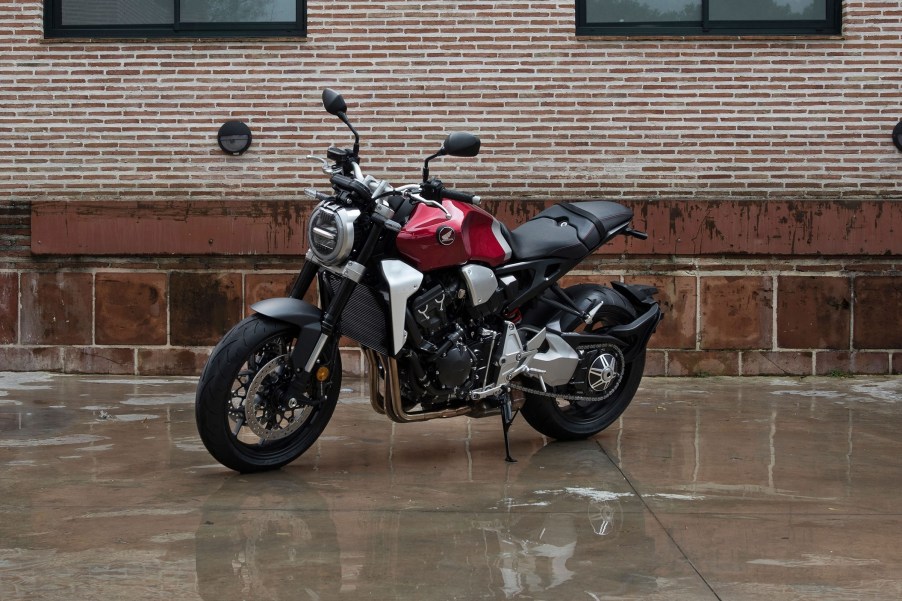
2020 Kawasaki Z900RS Cafe vs. 2019 Honda CB1000R: Which Captures the UJM Spirit Better?
When the Honda CB750 launched in 1969, it helped create a new kind of bike: the Universal Japanese Motorcycle. Over the next few years, other Japanese manufacturers like Kawasaki would release UJMs of their own. Eventually, this class of bike morphed into the standard motorcycle segment. This, given the current retro trend, gives us the 2020 Kawasaki Z900RS Café and 2019 Honda CB1000R. But which one should you consider?
The 2020 Kawasaki Z900RS Café and 2019 Honda CB1000R are retro but not old-school

The 2019 Honda CB1000R and 2020 Kawasaki Z900RS Café have a few things in common. They’re both four-cylinder motorcycles, they both have ABS, 6-speed transmissions, and slipper-assist clutches, and they both cost more than $10k. But the CB1000R and Z900RS Café start to drift apart after that.
The $12,999 2019 Honda CB1000R has a 998cc liquid-cooled inline-4 engine that, on Cycle World’s dyno, delivers 120 hp and 69 lb-ft at the rear wheel. Honda claims the engine makes 144 hp and 77 lb-ft at the crank, CW reports. And to help corral its output, the CB1000R has three riding modes and traction control, a fully-adjustable Showa fork, and an adjustable Showa rear shock.

The $11,799 2020 Kawasaki Z900RS Café, in contrast, has a 948cc liquid-cooled inline-4. On CW’s dyno, it delivers 95 hp and 64 lb-ft at the rear wheel. Kawasaki claims the Z900RS Café makes 111 hp and 72 lb-ft at the crank, RideApart reports. And while the Z900RS Café is down on power, it’s also up on weight. The Honda CB1000R weighs 467 pounds, and the Kawasaki weighs 479 pounds.
However, while the Z900RS Café weighs a bit more, it also has some extra features. Like the CB1000R, it has traction control, a fully-adjustable front fork, and an adjustable rear shock. But instead of an LCD screen, it has a TFT display with smartphone connectivity, CW reports. Plus, the Café model has a cowl-like windscreen.

The Kawasaki Z900RS Café also has slightly different proportions to the Honda CB1000R. The Kawasaki’s seat is slightly lower and its wheelbase is slightly longer. Plus, instead of a conventional handlebar, it has clip-on bars.
The Honda CB1000R is smooth, but the Kawasaki Z900RS Café “delivers everything” of the UJM ethos, Cycle World says
Standard bikes, and therefore UJMs, are meant to be a kind of ‘do-it-all’ machine. In that regard, both the 2019 Honda CB1000R and 2020 Kawasaki Z900RS Café channel their predecessors well, CW reports. However, one does so with a bit more aplomb than the other.
The Honda CB1000R’s powertrain is best described as “smooth,” CW reports. It has plenty of low-end torque, though, for back-country roads, you need to keep the revs high. But with less weight to carry, the CB1000R feels nimble and neutral, as well as stable in the corners.
However, compared to the Kawasaki, its riding position is more “aggressive,” CW notes. The CB1000R’s footpegs are higher and the rider often slides forward in the seat. It’s not uncomfortable, though, Rider reports. But while the engine is smooth, it’s perhaps a bit too much so, CW reports. Admittedly, ‘character’ is highly subjective—but then, retro motorcycles sell precisely by that metric.
The Honda CB1000R’s engine also gives up mid-range power to the Kawasaki Z900RS Café, Rider reports. So, while on paper the Honda is faster, the Kawasaki can sometimes out-accelerate it in the real world. Plus, its peak torque comes sooner in the rev range, making for better around-town acceleration, CW reports. And it sounds better, Rider reports.
The Kawasaki Z900RS Café also delivers a sportier riding experience than the CB1000R. True, it scrapes its footpegs earlier than the Honda does. But it also stops shorter and rides just as comfortably while feeling more stable in the corners and still nimble. And despite the lower seat height and clip-on bars, the riding position is surprisingly “relaxed,” Gear Patrol reports. The Z900RS has better brake feel, too, and that cowl provides genuine wind protection on the highway.
As a result, in comparing these two modern UJMs, Cycle World gave the nod to the Kawasaki. To quote, it “most successfully walks the line between performance and nostalgia.”
What about the 2021 models?
However, while both Cycle World and Rider preferred the 2020 Kawasaki Z900RS Café to the 2019 Honda CB1000R, these bikes are getting 2021 models.

For 2021, the Kawasaki Z900RS Café is basically unchanged. The only new item is a gray-and-silver livery instead of the green-and-white one. And the MSRP is now $11,899.
The Honda CB1000R’s 2021 updates are a bit more extensive, RideApart reports. Besides revised styling, the bike now has a TFT display and Bluetooth connectivity. And there’s now a USB port under the seat, Bennetts reports. There’s also a new Black Edition which comes with blacked-out trim, a flyscreen, and a quick-shifter. But mechanically, the powertrain is the same.
Ultimately, deciding between the two depends on personal comfort. So, get a test ride on both and see which one you prefer. Though it’s worth pointing out Kawasaki offers adjustable handlebars, seats, and footpegs for the Z900RS Café. After all, can’t have UJM without the ‘U.’
Follow more updates from MotorBiscuit on our Facebook page.


